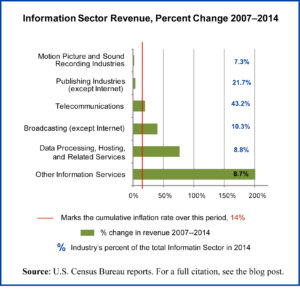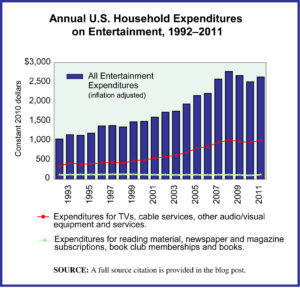
Year: 2000, 2009, 2019
Market size (display): 50.6 million pounds, 31.7 million pounds, and 24.1 million pounds, respectively
Market size (consumer): 102 million pounds, 182.2 million pounds, and 248.9 million pounds, respectively
For many, Independence Day celebrations aren’t complete without fireworks, either large professional displays or smaller pyrotechnics in one’s yard. Today’s market size shows the amount of fireworks consumed in 2000, 2009, and 2019 both by professional displays and by consumers. Even before many fireworks shows were canceled in 2020 due to the pandemic, the amount of fireworks used in professional displays has been going down, a drop of more than 52% from 2000 to 2019. Meanwhile, the cost of display fireworks went from $203 million in 2000 to $375 million in 2019, a nearly 85% jump. With the added costs of not just the fireworks, but the cost of hiring professional pyrotechnic experts, insurance, and police, fire, and paramedic presence, many cities and towns have found it cost-prohibitive to continue their annual fireworks displays or have scaled them back. In some cases, cities and towns have looked to sponsors to fund all or most of their events, with mixed success. In certain parts of the country prone to drought conditions, especially in the West, fireworks displays and consumer fireworks have been banned altogether. Consumption of consumer fireworks followed an opposite trend over this time period. From 2000 to 2019, sales of consumer fireworks jumped 144% (pound basis), and revenue jumped 145%.
In 2019, the United States imported $319.3 million worth of fireworks. Nearly 96%, or $304.5 million, came from China. Other countries in the top 5 include Spain ($4.8 million), Hong Kong ($4.6 million), Thailand ($1.7 million), and Germany ($1.4 million). Which states import the most? Missouri topped the list both by value ($51.1 million) and per capita ($8.34). Following Missouri by value were Mississippi ($42.3 million), Ohio ($30.4 million), Alabama ($28.4 million), and South Carolina ($18.9 million). Per capita, Alabama ($5.80), Kansas ($5.53), Wyoming ($4.07), and South Carolina ($3.72) round out the top 5.
The United States also exports fireworks, but the export value is only a fraction of imports: $5.6 million in 2019. The top states for exports include New Jersey, Florida, Montana, New York, and Alabama. Only New Jersey and Florida exported a total of more than $1 million: $1.9 million and $1.7 million, respectively. According to Thomasnet.com, the leading fireworks manufacturers in the United States based on estimated annual sales include TNT Fireworks, Young Explosives, International Fireworks Co., Fireworks by Grucci Inc., Santore & Sons Inc., Dominion Fireworks Inc., American Fireworks, Fireworks Supermarkets, and Rozzi’s Famous Fireworks Inc. Leading novelty fireworks suppliers include Zambelli Fireworks Manufacturing Co., Wholesale Fireworks, Atomic Fireworks Wholesale, Galaxy Fireworks Inc., and Pyro Direct. Both Santore & Sons and Zambelli Fireworks have been in business since the 1890s.
Sources: “U.S. Fireworks Consumption Figures 2000-2019,” American Pyrotechnics Association available online here; “U.S. Fireworks Industry Revenue Figures Breakdown by Industry Segment 1999-2019,” American Pyrotechnics Association available online here; Sterling Price, “Fourth of July: Who Uses the Most Fireworks in the US?” ValuePenguin, June 26, 2020 available online here; Christian Cavallo, “The Top Fireworks Manufacturers and Suppliers in the USA,” Thomas Publishing Company available online here; “Economy Affecting Fireworks Displays?” abc7ny, July 3, 2008 available online here; Brad Tuttle, “Why Your Town Isn’t Having a July 4 Fireworks Show This Year,” Money, June 29, 2016 available online here; Curt Yeomans, “Fireworks Shows Carry Big Costs for Local Cities,” Gwinnett Daily Post, June 30, 2019 available online here.Image source: Free-Photos, “sparkler-usa-american-flag-united-839806,” PIxabay, July 12, 2015 available online here.









